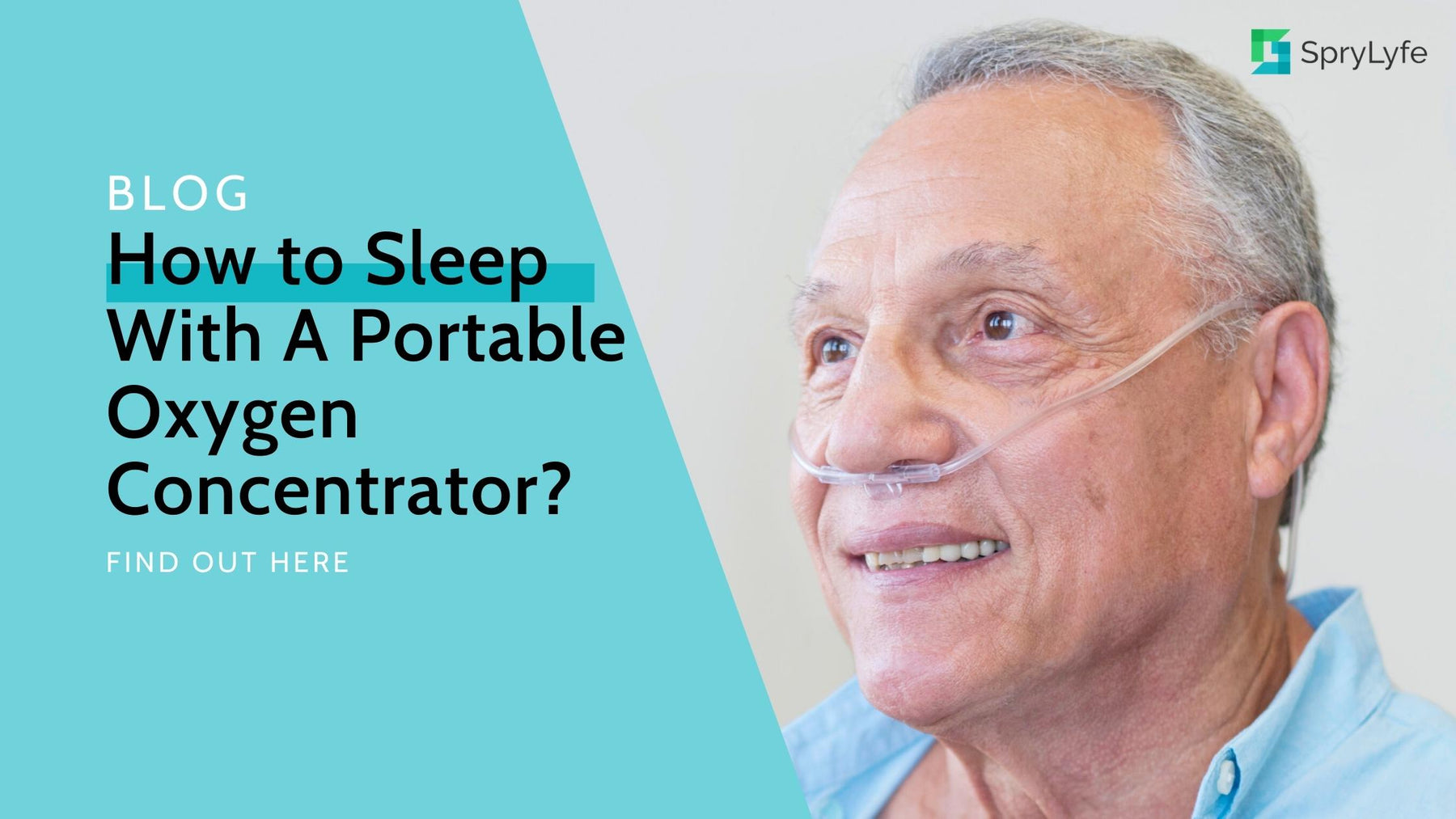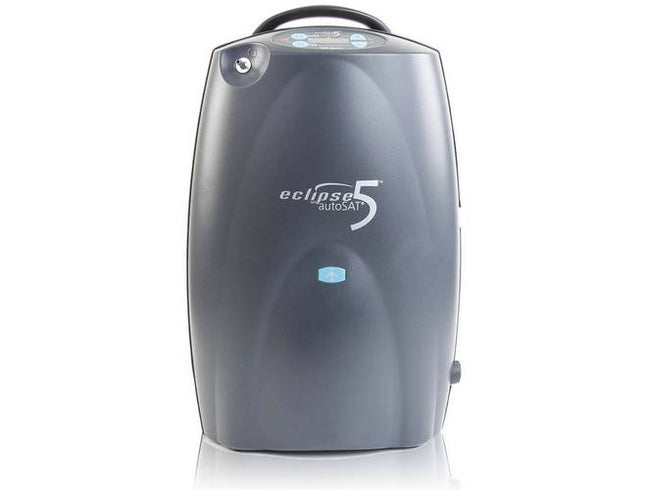
How to Sleep with A Portable Oxygen Concentrator?
Is the question "how to sleep with a portable oxygen concentrator" circling your mind lately? Keep an eye out today because here's everything you need to know.
We will guide you to different pointers and information about sleeping while undergoing oxygen therapy. However, let us answer the main question first before moving on to the detailed discussion.
How To Sleep With A Portable Oxygen Concentrator?
- Turn on the Sleep Mode or Intelligent Delivery Technology. Doing this will enable the oxygen concentrator to work specifically for night use.
- Switch to a continuous flow if you use CPAP or BiPAP machine for other respiratory treatments.
- Ensure that the oxygen mask or cannula does not make you feel uncomfortable. Use paddings to prevent pain.
- Make sure that your unit has sufficient charge.
- Ensure that the filters are clean
How Respiratory Problems Affect Your Quality of Sleep
People with respiratory problems and lung diseases often suffer from a disrupted sleep cycle at night due to breathing difficulties. Moreover, they can also experience coughing, chest pain, and soreness during sleep.
To help you understand this topic, we have listed four major respiratory problems and how they affect your sleep quality.
Chronic Obstructive Pulmonary Disease (COPD)

Unfortunately, nighttime symptoms of people suffering from lack of sleep due to chronic obstructive pulmonary disease often get unnoticed. These symptoms can comprise breathlessness, cough, chest pain, and dyspnea. It also includes reversible airway disorders, as seen in chronic airway obstruction, asthma, and chronic obstructive lung disease due to paralyzed vocal cords.
A study shows that 53% of the patients suffer from poor sleep quality due to COPD. Some reasons for their interrupted sleep due to COPD are the urge to use the bathroom, getting up early in the morning, suddenly waking up late at night, coughing and snoring loudly, and getting bad dreams.
Restrictive Lung Disorders
Restrictive lung disorders may include neuromuscular disorders, pleural diseases, massive obesity, and scoliosis. Furthermore, it can also be parenchymal lung disease that increases dyspnea and respiratory drive. It interrupts the continuity of one's sleep and leads to sleep-related hypoxemia or hypoventilation.
Hypoventilation Syndromes
Hypoventilation syndrome is a common disorder in people with COPD. It leads to a mechanical ventilation restraint and increased carbon dioxide production. It requires the patient to have excessive efforts in breathing while awake in the daytime and causes increased hypercapnia when asleep.
Consequently, patients with this syndrome often get interrupted in their sleep because of the necessity to breathe harder than usual.
Obstructive Sleep Apnea

About 22 million Americans are suffering from obstructive sleep apnea, and 80% do not undergo diagnosis. This disorder causes the breathing to repeatedly stop and restart due to the relaxing and obstructing throat muscles in the airways. It leads to a lack of sleep, daytime drowsiness, heart problems, risk of high blood pressure, and stroke, plus it is often associated with rapid eye movement (REM).
Its effect on disrupting one's sleep cycle can also result in neurocognitive dysfunction, decreased productivity, and increased risk of motor vehicle accidents.
Can Portable Oxygen Concentrators Help You Sleep Better?

Portable oxygen concentrators aim to maintain an average oxygen level and prevent them from falling to disruptive levels. It helps you avoid losing your oxygen supply, especially when sleeping at night. It also provides continuous oxygen delivery into your bloodstream so that your body organs can function correctly.
Consequently, using oxygen concentrators while sleeping can make you feel more comfortable, improving your sleep quality and duration. It enhances your mood, stamina, mental alertness, and energy to carry out daily activities and functions.
However, you will still need to consider some factors to ensure that you will get a better night's sleep with a portable oxygen concentrator.
How To Choose A Non-Disruptive Portable O2 Concentrator
You can find many portable oxygen concentrators in the marketplace, but some are specifically suitable and intended for non-disruptive use at nighttime. To help you find that oxygen machine, we offer you these five factors to consider when buying one.
1. Oxygen Flow
Among the two flow types of an oxygen concentrator, continuous flow oxygen is more advisable for constant use. Since it delivers a steady stream of oxygen, you will most likely get uninterrupted, regardless of your breathing rate and pattern.
Learn: How much Oxygen does a portable oxygen concentrator produce?
2. Energy Consumption
Most portable oxygen concentrators consume different amounts of energy, so it is best to look for one with minimal power consumption to guarantee that it will not be low in battery immediately.
Check the product and ask the seller if it usually uses too much. If yes, consider searching for other brands.
Read more: How many watts does a portable oxygen concentrator use?
3. Noise Level
Portable oxygen concentrators can also become noisy when in use. You can get disturbed in your sleep, especially when you are a light sleeper. For this reason, you will need to find an oxygen machine with a noise level of around 40-58 decibels.
Discover: What are the most quiet portable oxygen concentrators?
4. Power Source
You can get your portable oxygen concentrator powered using an electrical outlet or batteries. However, it is better to use a battery-powered oxygen tank, so sudden power disruptions cannot interrupt your oxygen therapy. You can still use it continuously anywhere and anytime.
Nonetheless, you will still need to ensure that your batteries have adequate charge.
5. Weight of Unit
Portable oxygen concentrators will never be as they are if they are not portable. Ones that weigh around 2 to 4 kilograms are the most preferable to ensure that it will not be burdensome to bring them everywhere.
Discover: What is the lightest portable oxygen concentrator?
How To Sleep Comfortably With A Portable Oxygen Concentrator?
Sleeping with a portable oxygen concentrator can be uncomfortable and painful for some patients. They can experience side effects that can interrupt their sleep. Nevertheless, we have come up with five ways how you can sleep comfortably during oxygen therapy.
Use nasal gel and sprays
Nasal gel and sprays can help when humidifiers cannot handle the situation alone. You can apply nasal gels to your skin underneath and inside your nose. It will seal in moisture in your nasal passage.
Using nasal gels also reduces soreness and friction due to the prongs of the nasal cannula. However, remember not to use petroleum products before using a portable oxygen concentrator because both are highly flammable. You can be at risk of getting burned, so look for non-petroleum and water-based nasal gels.
Meanwhile, saline sprays can be soothing and lubricating, reducing discomfort, pain, and the risk of infections. Ensure to find or purchase plain ones with merely water and salt and not the medicated ones.
Moisturize your skin
Who would not get disturbed with tubing, head straps, and other equipment rubbing against your skin while sleeping? Fortunately, you can use moisturizers to reduce inflammation and friction due to these circumstances. It will also prevent dry patches and skin irritation.
Use pillows or paddings
The edges of your oxygen mask, straps, and tubings can press against your skin, causing discomfort. To make situations more comfortable, you can use foam or fabric paddings and place them on your cheeks, nose, and similar areas where you feel pain.
For instance, small cheek pads are suitable for reducing the pain and pressure on the ears caused by the nasal cannula. Rubber pads and soft gel pads are perfect for the bridge on your nose where the oxygen mask usually rests. Lastly, you can use padded fabric covers to reduce pressure, preventing visible red marks that straps can leave on the face.
Wear the mask or cannula comfortably
Ensure that your nasal cannula or oxygen mask is not too big or too tight. It is advisable not to use materials that do not fit your face because it will most likely cause unnecessary friction and pain while sleeping. Buy soft nasal cannula and fitted oxygen mask to ensure quality sleep.
Ensure clean filters
Your concentrator pulls in air from the room and processes it to remove impurities like dust, pollen, and smoke. The filter helps to protect the internal components of the machine and ensures that you're breathing in clean, pure oxygen.
Over time, the filter will become clogged with contaminants and will need to be cleaned, or replaced. Depending on the model of concentrator, you may need to change the filter every few months or so. Failure to do so can lead to a drop in performance and, in some cases, damage to the machine. So when using an oxygen concentrator, be sure to keep those filters clean.
Keep the unit charged
Ensure that your portable concentrator is sufficiently charged, so you have enough oxygen supply that will last through the night.
If your POC is running low on battery power, it may not be able to provide you with the oxygen you need throughout the night. That's why it's important to make sure your POC is fully charged before going to bed. You may also want to consider investing in a backup battery pack, just in case your primary power source fails.
Get humidifiers
Nasal dryness and nose bleeds can significantly interrupt your night's sleep. They can be uncomfortable, making you feel restless throughout the night. In this case, using oxygen and home humidifiers can ease the situation.
You can ask your respiratory therapist for a humidifier bottle for your oxygen machine if you're using a stationary concentrator. Then, you can fill it up with distilled water and hook it up to your tubing. It will give you a more humid and moist air when it enters your mask and cannula.
On the other hand, you can also consider using home humidifiers for small rooms to moisturize the air inside. Consequently, these humidifiers will prevent nasal dryness and dry skin, making you feel more comfortable breathing while sleeping.
5 Best Portable Oxygen Concentrators for a Good Night's Sleep
Picking out the best portable oxygen concentrator can guarantee a more effective and accessible usage. You can buy an oxygen tank with intelligent technology and sleep mode to have a better night's sleep.
Fortunately, we have listed five of the most advisable portable oxygen concentrators for patients who need an oxygen supply 24/7. Check these products below!
1. Respironics SimplyGo
Many patients have believed that Respironics SimplyGo is the best portable oxygen concentrator for 24/7 usage. It supports both pulse and continuous flow with a flow setting of 1 to 6 and 0.5 to 2 liters per minute, respectively. It can be of great advantage for those who need oxygen at night.
Respironics SimplyGo has a sleep mode technology, which delivers a constant oxygen supply while sleeping. It tends to increase its sensitivity to sense your breathing rate. It also softens its oxygen delivery in pulse flow to prevent waking you up.
Fear not about getting an inadequate oxygen supply because this machine automatically switches to its continuous mode if it fails to detect your breath. Lastly, Respironics SimplyGo is also CPAP and BiPAP compatible.
2. Inogen One G3
The Inogen One G3 has been a popular portable oxygen concentrator in the marketplace for over two years. Despite being a pulse flow machine, it carries benefits that continuous flow machines can give!
Generally, respiratory therapists do not advise pulse mode because they cannot detect mouth breaths. However, Inogen One G3 can sense and respond to any breathing rate. It can give you the needed oxygen supply during the decrease of oxygen rate at night with its pulse flow setting.
This oxygen tank also has an Intelligent Delivery Technology. It can immediately deliver oxygen for the first 400 seconds of detecting your breathing rate. It is also lightweight and has a long battery life of 8 hours.
3. Oxlife Freedom
Use Oxlife Freedom anytime you want because it is perfect for 24/7 use. It has a long battery life with a quick recharge time, suitable for emergency errands, busy days, family gatherings, and similar circumstances.
Fear not about falling asleep as a light sleeper because you can turn its quiet operation on to avoid disturbing you and everyone else in the room. It also supports an Intelligent Delivery Technology that can provide supplemental oxygen at night at the correct rate and amount. It can also adjust its dosage based on your needs.
4. Inogen One G5
Sleep at night comfortably because the Inogen One G5 also boasts its Sleep Mode Technology. It increases its bolus dose of oxygen once your breathing rate gets different and more shallow.
If you tend to breathe using your mouth, this oxygen machine will be able to detect your breathing rate, even when sleeping. It will then adjust itself to provide you with the adequate oxygen supply your body needs.
Using a double battery, you can use Inogen One G5 for about 13 hours. You can also bring it anywhere you like because it is only 4.7 lbs.
5. SeQual Eclipse 5
The final product on our extensive list is the SeQual Eclipse 5 under CAIRE. This portable oxygen concentrator also supports pulse and continuous flow. It has a flow setting of 0.5 to 3 LPM and 9 LPM, respectively.
Like the previous products stated above, SeQual Eclipse 5 also has a sleeping mode, perfect for 24/7 usage. It is also CPAP and BiPAP compatible and delivers reliable oxygen with 90% purity.
FAQs About Sleeping While With Portable Oxygen Concentrator
Some frequently asked questions and inquiries about sleeping with a portable oxygen concentrator are the following:
Can I sleep with my portable oxygen concentrator?
Yes. Sleeping with an oxygen concentrator can serve as supplemental oxygen, significantly when your oxygen level decreases at night. It improves your sleep quality and prevents various complications and risks due to lack of sleep. You only need to make yourself comfortable as you use it while sleeping.
How do you sleep with an oxygen concentrator?
Before sleeping, you will need to turn on the sleep mode or the intelligent delivery system. You can also change the settings and turn it into continuous mode if you simultaneously use a BiPAP or CPAP machine. Moreover, ensure that the mask or cannula fits your face comfortably so you won't get restless while using it.
Can you use a portable oxygen concentrator full time?
Yes. Most high-quality portable oxygen concentrators can be usable 24 hours a day and seven days a week. They can be suitable for people who need a continuous oxygen supply during any daily activity and while sleeping. These oxygen machines do not require oxygen refills, so you won't need to worry about a sudden loss of supply.
Can you leave an oxygen machine on all night?
Yes. It will not cause any problem or harm if you leave your portable oxygen concentrator on throughout the night. Instead, it will help you provide a sustained oxygen supply while sleeping to prevent a lack of sleep and further complications. However, ensure that you use your oxygen machine correctly to avoid safety risks.
What are the risks of using a portable oxygen concentrator when sleeping?
There may be risks to using a portable oxygen concentrator, but they should not alarm you because most patients encounter them. These risks include disturbance due to noisy oxygen machines, nose dryness, skin irritation, and high oxygen saturation levels resulting from excessive oxygen rates.
Can a portable oxygen concentrator help me sleep at high altitude?
Yes. Using a portable O2 concentrator can help you get much-needed oxygen supply at high altitude. Some people find it difficult to sleep at high altitude, due to the lack of oxygen in the air. This can be a serious problem for those who live in or frequently travel to mountainous regions.
A portable oxygen concentrator can help to alleviate these symptoms by providing a steady supply of oxygen-enriched air. The concentrated oxygen can help to improve blood oxygen levels, making it easier to breathe and sleep.
Additionally, portable oxygen concentrators are small and lightweight, making them easy to take with you on trips. So if you're looking for a way to get a good night's sleep at high altitude, a portable oxygen concentrator may be the answer.

Get Your Much Deserved Good Night’s Sleep With A Portable Oxygen Concentrator!
It only takes a few reminders on how to sleep with a portable oxygen concentrator comfortably. Do not hesitate to undergo oxygen therapy at night when your body needs it.
You can be extra careful when picking out an oxygen concentrator and be cautious when using it for more comfortable usage. Since you have already gone through this article, we hope you have gained ideas about sleeping with one.
If you already have a prescription from your doctor, browse through our top-rated portable oxygen concentrator products for sale, or call us at (800) 314-8225, so our oxygen specialists can assist you.







Leave a comment